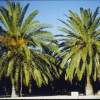Abstract
The Canary Island date palm is native to the Canary Islands. Although it can reach heights of 40–50 feet, it is slow growing and requires many years to attain that height. It has 8- to 15-foot-long rigid leaves that contain up to 200 V-shaped leaflets, the basal ones of which are modified into long, sharp spines. Leaves are not self-cleaning and must be manually removed when dead, but the leaf bases eventually rot off, leaving an attractive diamond-shaped pattern of leaf scars on the 2- to 3-foot-diameter trunk. On older specimens, the basal foot or so of the trunk typically is covered with short root initials. This 6-page fact sheet was written by T. K. Broschat, and published by the UF Department of Environmental Horticulture, August 2013.
References
Broschat, T. K. 1997. "Nutrient Distribution, Dynamics, and Sampling in Coconut and Canary Island Date Palms." J. Amer. Soc. Hort. Sci. 122: 884-890. https://doi.org/10.21273/JASHS.122.6.884
Elliott, M. L., T. K. Broschat, J. Y. Uchida, and G. W. Simone. 2004. Compendium of Diseases and Disorders of Ornamental Palms. St. Paul, MN: American Phytopathological Society. https://doi.org/10.1094/APSnetFeature-2004-0304
Meerow, A. W. 2006. Betrock's Landscape Palms. Hollywood, FL: Betrock Info. Systems.
Unless otherwise specified, articles published in the EDIS journal after January 1, 2024 are licensed under a Creative Commons Attribution-NonCommercial-NoDerivs 4.0 International (CC BY-NC-ND 4.0) license.

